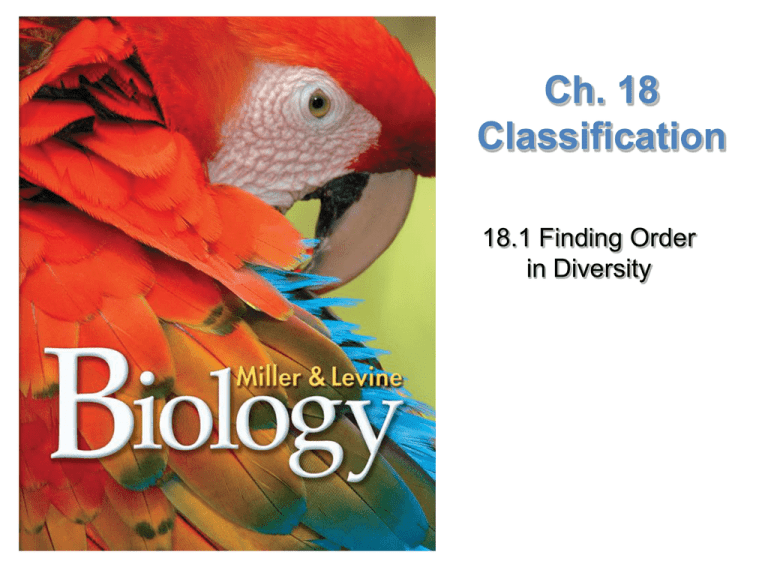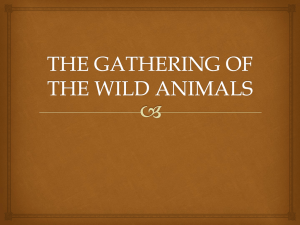
Lesson Overview
Finding Order in Diversity
Ch. 18
Classification
18.1 Finding Order
in Diversity
Lesson Overview
Finding Order in Diversity
THINK ABOUT IT
Scientists have been trying to identify, name,
and find order in the diversity of life for a long
time. The first scientific system for naming and
grouping organisms was set up long before
Darwin.
In recent decades, biologists have been
completing a changeover from that older system
of names and classification to a new strategy
based on evolutionary theory.
Lesson Overview
Finding Order in Diversity
Assigning Scientific Names
The first step in understanding and studying
diversity is to describe and name each species.
By using a scientific name, biologists can be sure
that they are discussing the same organism.
Common names can be confusing because they
vary among languages and from place to place.
For example, the names cougar, puma, panther,
and mountain lion can all be used to indicate the
same animal— Felis Concolor.
Lesson Overview
Finding Order in Diversity
Assigning Scientific Names
In the eighteenth century, European scientists
agreed to assign Latin or Greek names to each
species. Early scientific names often used long
phrases to describe species in great detail.
For example, the English translation of the
scientific name of a tree might be “Oak with
deeply divided leaves that have no hairs on their
undersides and no teeth around their edges.”
It was also difficult to standardize names because
different scientists focused on different
characteristics
Lesson Overview
Finding Order in Diversity
Binomial Nomenclature
In the 1730s, Swedish
botanist Carolus Linnaeus
developed a two-word
naming system called
binomial nomenclature.
The scientific name usually is
Latin. It is written in italics.
The first word begins with a
capital letter, and the second
word is lowercased.
Lesson Overview
Finding Order in Diversity
Ursus arctos
(grizzly bear)
Ursus americanus
(black bear)
The first part of the name is the genus to which the
organism belongs. A genus is a group of closely
related species. The genus name is capitalized.
The second part of the name is unique to each
species within the genus. This part of the name
often describes an important trait or where the
organism lives. The species name is lowercased.
Copyright Pearson Prentice Hall
Lesson Overview
Finding Order in Diversity
Classifying Species into Larger Groups
In addition to naming organisms, biologists try to
organize, or classify, living and fossil species into
larger groups that have biological meaning.
Biologists often refer to these groups as taxa
(singular: taxon).
The science of naming and grouping organisms is
called systematics. Previously, it was referred to
as taxonomy.
Lesson Overview
Finding Order in Diversity
Linnaean Classification System
Linnaeus also developed a classification system
that organized species into a hierarchy, or
ranking.
In deciding how to place organisms into larger
groups, Linnaeus grouped species according to
anatomical similarities and differences.
Lesson Overview
Finding Order in Diversity
Seven Levels
Linnaeus identified just four levels in his original
classification system.
Over time, Linnaeus’s original classification system
would expand to include seven taxa: species,
genus, family, order, class, phylum, and
kingdom.
Lesson Overview
Finding Order in Diversity
Species and genus are the two smallest categories.
Grizzly
bear
Black
bear
Copyright Pearson Prentice Hall
Lesson Overview
Finding Order in Diversity
Genera that share many characteristics are
grouped in a larger category, the family.
Grizzly
bear
Black
bear
Copyright Pearson Prentice Hall
Giant
panda
Lesson Overview
Finding Order in Diversity
An order is a broad category composed of similar
families.
Grizzly
bear
Black
bear
Giant
panda
Red
fox
This order also contains the families Canidae
(dogs) and Felidae (cats).
Copyright Pearson Prentice Hall
Lesson Overview
Finding Order in Diversity
The next larger category, the class, is composed
of similar orders.
Grizzly
bear
Black
bear
Giant
panda
Red
fox
Abert
squirrel
Class Mammalia
All mammals are warm-blooded, have body hair,
and produce milk for their young.
Copyright Pearson Prentice Hall
Lesson Overview
Finding Order in Diversity
Several different classes make up a phylum.
Grizzly
bear
Black
bear
Giant
panda
PHYLUM
Red
fox
Chordata
Copyright Pearson Prentice Hall
Abert
squirrel
Coral
snake
Lesson Overview
Finding Order in Diversity
The kingdom is the largest and most inclusive of
Linnaeus's taxonomic categories.
Grizzly
bear
Black
bear
Giant
panda
Red
fox
Abert
squirrel
KINGDOM Animalia
Copyright Pearson Prentice Hall
Coral
snake
Sea
star
Lesson Overview
Finding Order in Diversity
Problems With Traditional Classification
In a way, members of a species determine which
organisms belong to that species by deciding with
whom they mate and produce fertile offspring.
Ranks above the level of species, however, are
determined by researchers who decide how to
define and describe genera, families, orders,
classes, phyla, and kingdoms.
Linnaeus grouped organisms into larger taxa
according to overall similarities and differences.
But which similarities and differences are the most
important?
Lesson Overview
Finding Order in Diversity
Problems With Traditional Classification
Modern classification schemes look beyond
overall similarities and differences and group
organisms based on evolutionary
relationships.










